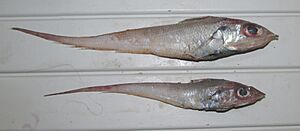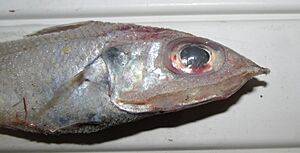Hollowsnout grenadier facts for kids
Quick facts for kids Hollowsnout grenadier |
|
|---|---|
 |
|
| Conservation status | |
| Scientific classification | |
| Synonyms | |
|
The hollowsnout grenadier (Coelorinchus caelorhincus) is a type of fish. It is also known as the blackspot grenadier. This fish belongs to the Macrouridae family, which are often called rattails because of their long, thin tails. Its name comes from Greek words meaning "hollow snout."
Contents
What Does the Hollowsnout Grenadier Look Like?
The hollowsnout grenadier has a shiny, silvery color. It can grow to be about 48 cm (1.57 ft) long.
Where Do Hollowsnout Grenadiers Live?
Hollowsnout grenadiers live in the deep waters of the Atlantic Ocean and the Mediterranean Sea. They are benthopelagic fish. This means they live near the bottom of the ocean but can also swim in the open water just above it. They are found at depths from about 90–1,485 m (295–4,872 ft).
Older and larger hollowsnout grenadiers usually live in deeper water. Younger, smaller fish, called fry, prefer shallower areas.
How Do Humans Interact with This Fish?
Hollowsnout grenadiers are often caught by accident. This happens when fishing boats are deep-sea trawling for shrimp or lobster. When fish are caught by accident, they are called by-catch. People usually do not eat hollowsnout grenadiers.
What Do Hollowsnout Grenadiers Eat?
The hollowsnout grenadier eats many different kinds of sea creatures. They mostly hunt small animals that live on the ocean floor. These include tiny benthic crustaceans like amphipods, isopods, and tanaids. They also eat polychaetes, which are a type of marine worm.
Sometimes, they will also hunt other fish, called teleost fish, and some types of cephalopods, like squid. Their diet can change with the seasons. In colder weather, they are less likely to hunt bigger prey like fish or cephalopods.



